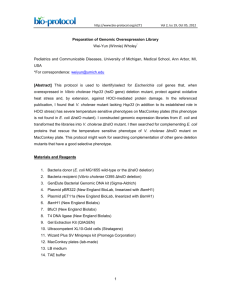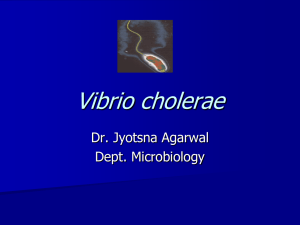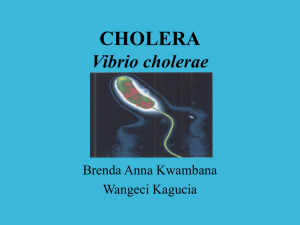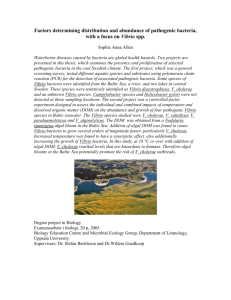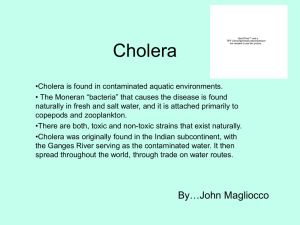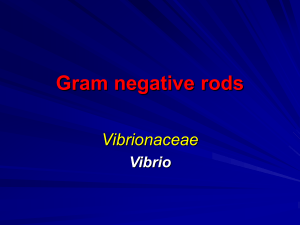Roles of the Sodium-Translocating NADH:Quinone Oxidoreductase (Na
advertisement
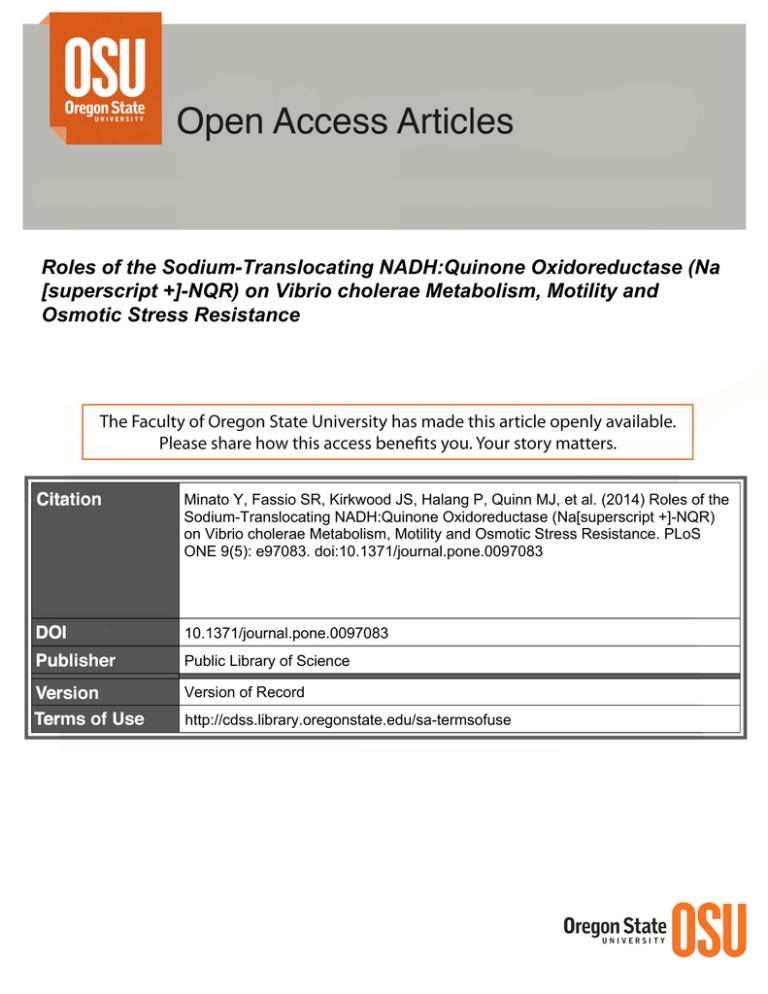
Roles of the Sodium-Translocating NADH:Quinone Oxidoreductase (Na [superscript +]-NQR) on Vibrio cholerae Metabolism, Motility and Osmotic Stress Resistance Minato Y, Fassio SR, Kirkwood JS, Halang P, Quinn MJ, et al. (2014) Roles of the Sodium-Translocating NADH:Quinone Oxidoreductase (Na[superscript +]-NQR) on Vibrio cholerae Metabolism, Motility and Osmotic Stress Resistance. PLoS ONE 9(5): e97083. doi:10.1371/journal.pone.0097083 10.1371/journal.pone.0097083 Public Library of Science Version of Record http://cdss.library.oregonstate.edu/sa-termsofuse Roles of the Sodium-Translocating NADH:Quinone Oxidoreductase (Na+-NQR) on Vibrio cholerae Metabolism, Motility and Osmotic Stress Resistance Yusuke Minato1¤, Sara R. Fassio2., Jay S. Kirkwood3,4., Petra Halang5, Matthew J. Quinn2, Wyatt J. Faulkner2, Alisha M. Aagesen2, Julia Steuber5, Jan F. Stevens3,4, Claudia C. Häse1,2* 1 Department of Biomedical Sciences, College of Veterinary Medicine, Oregon State University, Corvallis, Oregon, United States of America, 2 Department of Microbiology, College of Science, Oregon State University, Corvallis, Oregon, United States of America, 3 Linus Pauling Institute, Oregon State University, Corvallis, Oregon, United States of America, 4 Department of Pharmaceutical Sciences, Oregon State University, Corvallis, Oregon, United States of America, 5 Institute of Microbiology, University of Hohenheim, Stuttgart, Germany Abstract The Na+ translocating NADH:quinone oxidoreductase (Na+-NQR) is a unique respiratory enzyme catalyzing the electron transfer from NADH to quinone coupled with the translocation of sodium ions across the membrane. Typically, Vibrio spp., including Vibrio cholerae, have this enzyme but lack the proton-pumping NADH:ubiquinone oxidoreductase (Complex I). Thus, Na+-NQR should significantly contribute to multiple aspects of V. cholerae physiology; however, no detailed characterization of this aspect has been reported so far. In this study, we broadly investigated the effects of loss of Na+-NQR on V. cholerae physiology by using Phenotype Microarray (Biolog), transcriptome and metabolomics analyses. We found that the V. cholerae DnqrA-F mutant showed multiple defects in metabolism detected by Phenotype Microarray. Transcriptome analysis revealed that the V. cholerae DnqrA-F mutant up-regulates 31 genes and down-regulates 55 genes in both early and mid-growth phases. The most up-regulated genes included the cadA and cadB genes, encoding a lysine decarboxylase and a lysine/cadaverine antiporter, respectively. Increased CadAB activity was further suggested by the metabolomics analysis. The down-regulated genes include sialic acid catabolism genes. Metabolomic analysis also suggested increased reductive pathway of TCA cycle and decreased purine metabolism in the V. cholerae DnqrA-F mutant. Lack of Na+-NQR did not affect any of the Na+ pumping-related phenotypes of V. cholerae suggesting that other secondary Na+ pump(s) can compensate for Na+ pumping activity of Na+-NQR. Overall, our study provides important insights into the contribution of Na+-NQR to V. cholerae physiology. Citation: Minato Y, Fassio SR, Kirkwood JS, Halang P, Quinn MJ, et al. (2014) Roles of the Sodium-Translocating NADH:Quinone Oxidoreductase (Na+-NQR) on Vibrio cholerae Metabolism, Motility and Osmotic Stress Resistance. PLoS ONE 9(5): e97083. doi:10.1371/journal.pone.0097083 Editor: Joel H. Weiner, University of Alberta, Canada Received December 11, 2013; Accepted April 14, 2014; Published May 8, 2014 Copyright: ß 2014 Minato et al. This is an open-access article distributed under the terms of the Creative Commons Attribution License, which permits unrestricted use, distribution, and reproduction in any medium, provided the original author and source are credited. Funding: This research was supported by grants from the National Institutes of Health to C.C.H. [AI-063121-02] and to J.F.S [S10RR027878 and P30ES000210] and the Deutsche Forschungsgemeinschaft (FR1321/3-1) to J.S. S.R.F was partially supported by the OSU Undergraduate Research, Innovation, Scholarship & Creativity (URISC) fund and the OSU Howard Hughes Medical Institute Summer Undergraduate Research Program. The funders had no role in study design, data collection and analysis, decision to publish, or preparation of the manuscript. Competing Interests: The authors have declared that no competing interests exist. * E-mail: hasec@science.oregonstate.edu ¤ Current address: Department of Microbiology, University of Minnesota, Minneapolis, Minnesota, United States of America . These authors contributed equally to this work. to build a proton motive force (PMF). Unlike Na+-NQR and NDH-1, NDH-2 has neither H+ nor Na+ efflux activities. A few pathogenic bacteria, such as Yersinia pestis and Pseudomonas aeruginosa, have all three types of NADH dehydrogenases, but most bacteria possess one or two of these NADH dehydrogenases [5,6]. Lack of the major NADH dehydrogenase activity usually significantly affect bacterial physiology. Escherichia coli has a single NDH-1 (encoded by nuoA-N) and NDH-2 (encoded by ndh), and it is known that NDH-2 is the major enzyme for aerobic growth, whereas the NDH-1 is essential for anaerobic fumarate and DMSO respiration [7]. Moreover, it is known that the E. coli strain lacking NDH-1 showed growth retardation and increased acetate secretion after the transition to stationary growth phase when grown in mixed amino acids media [8]. It was also shown that the Introduction Na+-translocating NADH:quinone oxidoreductases (Na+-NQR) are found in the respiratory chains of a number of marine and pathogenic bacteria (reviewed in [1,2]). In organisms that express Na+-NQR, this enzyme is the gateway for electrons into the respiratory chain. Na+-NQR accepts reducing equivalents from NADH and donates them to the quinone pool [3,4]. The energy from this redox reaction is used to pump sodium ions from the inner to the outer side of the membrane, thereby building a sodium motive force (SMF). Besides Na+-NQR, two more types of respiratory NADHdehydrogenases have been reported, the proton-pumping NADH dehydrogenases (NDH-1 or Complex I) and NDH-2 [5]. Similar to Na+-NQR, NDH-1 utilizes energy from the redox reaction, but it pumps protons from the inner to the outer side of the membrane PLOS ONE | www.plosone.org 1 May 2014 | Volume 9 | Issue 5 | e97083 Na+-NQR and V. cholerae Physiology uM, 4.6 6 150 mm). Mass spectrometry was performed on an AB SCIEX Triple TOF 5600 quadrupole-time-of-flight mass spectrometer. MS/MS spectra were gathered on the fly by information dependent acquisition. Most metabolites were identified by mass, isotope distribution, MS/MS fragmentation, and when standards were available, retention time. In the absence of chemical standards, MS/MS spectra were compared to those in the METLIN online database. To account for analytical and sample preparation variation, samples were normalized to total ion count. Central energy metabolites (metabolites of the tricarboxylic acid cycle, pentose phosphate pathway, and glycolysis and amino acids) were targeted post-data acquisition and in addition, untargeted statistical analysis (Student’s t-test p-value plotted against fold-change) revealed large (.10-fold) changes in cyclic AMP and cyclic GMP, and subsequently, related metabolites (purines and pyrimidines) were targeted post-data acquisition. E. coli strain lacking NDH-1 grew poorly when grown in minimal media supplemented with acetate as the sole carbon source [8]. Vibrio cholerae is the causative agent of cholera, a waterborne severe diarrheal disease. Genome sequencing revealed that V. cholerae does not have NDH-1 but has Na+-NQR (encoded by nqrA-F) and NDH-2 (encoded by ndh) [2,6]. Although Na+-NQR is not essential for V. cholerae growth [9], the DnqrA-F mutant strain of V. cholerae shows a marked growth defect when grown in LB [10], similar to the E. coli strain that lacks a functional NDH-1 [8]. In addition, the V. cholerae Dnqr A-F mutant strain shows multiple defects in carbon metabolism [10]. Furthermore, Na+-NQR also affects V. cholerae virulence gene expression possibly by affecting acetyl-CoA metabolism via the TCA cycle [9,10] and survival in vivo [11]. In this study, we aimed to investigate the effects of a DnqrA-F mutation on broad aspects of V. cholerae physiology by using Phenotype Microarray (Biolog), transcriptome, and metabolomics analyses. We found that DnqrA-F mutant strain showed multiple defects in metabolism but did not show any defect in Na+ pumping-related phenotypes of V. cholerae. Growth measurement V. cholerae O395N1, V. cholerae O395N1 DnqrA-F [12] and V. cholerae O395N1 DpomAB [13] strains were used in this study. Bacterial strains were kept at 280uC in 20% glycerol stocks. Bacterial strains were grown in Luria-Bertani (LB) medium at 30uC or 37uC. Streptomycin was supplemented at 100 mg/ml. When necessary, 33 mM L-lactate was used. Growth measurement assays were performed as previously described [16]. Briefly, overnight grown bacterial cells were inoculated into 200 ml liquid medium in 96-deep-well plates (Whatman) at an initial OD600 of 0.05 and grown at 37 uC for 18 h with vigorous aeration. LBB medium (non-cationic L broth) was supplemented with streptomycin and varying concentrations of ethylene glycol. The initial pH of the media was adjusted with HCl to 6.5 and buffered by the addition of 60 mM BTP. Growth was then measured as OD600 by scanning the plates on a Bio-Rad iMark microplate absorbance reader. All experiments were repeated at least three times in triplicate. Phenotype microarray (PM) analyses Measurement of acetate excretion Materials and Methods Bacterial strains and growth conditions Phenotype microarrays were performed using PM3 to PM10 MicroPlate (Biolog) at Biolog’s PM Services group. All plates used pyruvate as sole carbon sources. Acetate excretions from bacterial cells were measured as previously described [10]. Motility assay DNA microarray analyses Motility of V. cholerae strains was determined on soft agar plates buffered with 100 mM Bis/Tris (pH 6.5) containing 100 mM NaCl, 0.25% agar, 1% tryptone, 0.5% yeast extract and 50 mg ml21 streptomycin. The endogenous Na+ content of the medium was 11 mM as determined by atomic absorption spectroscopy [17]. If indicated, D,L-lactate (33 mM final concentration) was added from a stock solution adjusted to pH 6.5 with KOH. To inoculate the swarming plates, overnight cultures of the DnqrA-F mutant strain, its parent strain or the non-motile V. cholerae O395N1 DpomAB [13] were diluted in LB medium to a starting OD600 of 0.01. Cells were grown until OD600 of 0.5–0.6 was reached and washed in fresh LB medium. Cell suspensions were adjusted to OD600 of 0.5 with LB, and aliquots of 1.5 ml were spotted on dried soft agar plates. The diameters of swarming diameters were determined after 16 h at 37uC. Mean values and standard error from 16 experiments are presented. P values were calculated using Student’s t test. Cells of V. cholerae O395N1 and V. cholerae O395N1 DnqrA-F strains, grown in LB (pH 6.5) at 30uC for 4 hours and 8 hours, were treated with RNA Protect Bacteria Reagent (Qiagen). RNA was extracted using the QIAGEN RNeasy Mini Kit (Qiagen). RNA was concentrated using the QIAGEN RNA MiniElute Cleanup kit (Qiagen) and sent to the Center for Genome Research and Biocomputing at Oregon State University, Corvallis, OR, following protocols outlined in the NimbleGen array user’s guide, version 5 for cDNA synthesis and microarray analysis using NimbleGen Microarray plates and reagents. The microarray data are accessible at the Gene Expression Omnibus (accession number, GSE56387). Metabolite extraction V. cholerae O395N1 and V. cholerae O395N1 DnqrA-F strains were grown in LB (pH 6.5) at 30uC for 2 hours and the supernatant was removed by centrifugation (8000 rpm, 4 uC, 5 min). The pellet was resuspended in 600 mL of LC-MS-grade water in 1 mM HEPES and 1 mM EDTA (pH 7.2). Metabolites were extracted from bacterial cells by using the boiling water method as previously described [14]. Results and Discussion The DnqrA-F mutant strain showed multiple defects in metabolism detected by the phenotype microarray We had previously performed a Phenotype Microarray (Biolog) analysis to address how a DnqrA-F mutation affects V. cholerae metabolism and changes in metabolic profiles were determined for the V. cholerae parent strain and the DnqrA-F mutant strain [10]. We had found that the DnqrA-F mutant has defects in the utilization of several TCA cycle intermediates (fumaric acid, succinic acid and LC-MS/MS Mass spectrometry based metabolomic profiling was performed as previously described [15]. Briefly, liquid chromatography (LC) was performed on a Shimadzu Nexera system and metabolites separated on an Inertsil phenyl-3 stationary phase (GL Sciences, 5 PLOS ONE | www.plosone.org 2 May 2014 | Volume 9 | Issue 5 | e97083 Na+-NQR and V. cholerae Physiology Table 1. Genes up-regulated in the DnqrA-F mutant based on microarray analysis. VC number Functions Fold change (early) Fold change (mid) VC0280 lysine/cadaverine antiporter, cadB 17.836 up 8.313 up VC0281 lysine decarboxylase, cadA 26.554 up 4.988 up VC0479 hypothetical protein 2.075 up 1.516 up VC0615 endoglucanase-related protein 1.709 up 1.568 up VC0620 peptide ABC transporter, periplasmic peptide-binding protein 1.686 up 2.131 up VC0786 D-amino acid dehydrogenase small subunit 2.512 up 1.881 up VC1203 urocanate hydratase 3.598 up 2.000 up VC1204 formimidoylglutamase 3.152 up 2.211 up VC1205 imidazolonepropionase 2.674 up 2.062 up VC1480 hypothetical protein 1.677 up 1.811 up VC1481 hypothetical protein 1.654 up 1.640 up VC1627 pH-dependent sodium/proton antiporter, nhaA 2.199 up 2.089 up VC1689 hypothetical protein 2.292 up 1.634 up VC1752 hypothetical protein 1.611 up 1.592 up VC1827 mannose-6-phosphate isomerase 6.706 up 1.662 up VC1828 hypothetical protein 2.703 up 1.629 up VC2216 hypothetical protein 2.216 up 1.527 up VC2361 autonomous glycyl radical cofactor GrcA 2.197 up 1.920 up VC2556 hypothetical protein 1.572 up 1.519 up VC2699 anaerobic C4-dicarboxylate transporter 3.431 up 1.509 up VCA0029 transcriptional regulator, putative 3.633 up 2.241 up VCA0562 hypothetical protein 1.674 up 1.585 up VCA0702 iron-containing alcohol dehydrogenase 1.770 up 1.841 up VCA0732 hypothetical protein 2.365 up 1.746 up VCA0744 glycerol kinase 1.653 up 2.770 up VCA0773 methyl-accepting chemotaxis protein 2.453 up 1.937 up VCA0811 N-acetylglucosamine-binding protein A 7.632 up 2.174 up VCA0827 pterin-4-alpha-carbinolamine dehydratase 1.542 up 2.797 up VCA0948 hypothetical protein 2.456 up 1.554 up VCA1045 PTS system, mannitol-specific IIABC component 1.732 up 2.479 up VCA1046 mannitol-1-phosphate 5-dehydrogenase 1.997 up 1.712 up doi:10.1371/journal.pone.0097083.t001 confirmed that lack of Na+-NQR broadly affects V. cholerae metabolism. L-malic acid) and many carbon sources that are metabolized into TCA cycle intermediates (L-aspartic acid, L-histidine, L-glutamine and L- glutamic acid). However, because succinic acid was used as the carbon source in the PM3-PM8 plates (nitrogen source, phosphorus source, sulfur sources and nutrient supplements testing plates), the systematic metabolic defects observed in the DnqrA-F mutant and effects of DnqrA-F mutation on these metabolisms were still uncertain. Our previous Phenotype Microarray results indicated that the DnqrA-F mutant utilizes pyruvate as the carbon source similar to the parent strain. Consistent with this, the DnqrAF mutant grew similar to the parent strain when grown in M9 minimal media supplemented with pyruvate as the sole carbon source (data not shown). Thus, we tested the PM3-PM8 again using pyruvate as a sole carbon source. The results of the phenotype microarray indicated that the V. cholerae O395N1 DnqrA-F mutant strain still showed multiple defects in nitrogen, phosphate and sulfur utilization (Table S1). Using PM 9 and PM 10 plates, we also tested the effects of osmolytes and pH and found that the DnqrA-F mutant is sensitive to sodium chloride, sodium sulfate, ethylene glycol, and urea (Table S1). These data again PLOS ONE | www.plosone.org Transcriptome analyses We next performed DNA microarray analyses to investigate how the lack of Na+-NQR broadly affects gene expression pattern in V. cholerae. We had previously found that the DnqrA-F mutant increased virulence gene expressions, including toxT, ctxB and tcpA, but only at the early phase of the logarithmic growth [18]. This finding suggested that the lack of Na+-NQR affected V. cholerae gene expressions differently at different phases of growth. Because we aimed to understand the overall changes of gene expression pattern in the DnqrA-F mutant strain, we performed microarray analyses using RNA prepared from bacterial cultures both at the early and late phases of the logarithmic growth. At the early logarithmic growth, 612 genes were up-regulated and 660 genes were down-regulated in the DnqrA-F mutant compared to the parent strain, whereas at the late logarithmic growth phase, 119 genes were up-regulated and 264 genes were down-regulated in the DnqrA-F mutant (data not shown). Consistent with our previous 3 May 2014 | Volume 9 | Issue 5 | e97083 Na+-NQR and V. cholerae Physiology Table 2. Genes down-regulated in the DnqrA-F mutant based on microarray analysis. VC number Functions Fold change (early) Fold change (mid) VC0022 hypothetical protein 1.657 down 1.644 down VC0061 thiamine biosynthesis protein ThiC 1.916 down 1.739 down VC0062 thiamine-phosphate pyrophosphorylase 1.935 down 1.724 down VC0063 thiF protein 1.730 down 1.864 down VC0302 putative 3-phenylpropionic acid transporter 2.403 down 1.821 down VC0730 copper homeostasis protein 1.675 down 1.647 down VC0734 malate synthase 2.689 down 1.789 down VC0751 co-chaperone HscB 1.651 down 1.828 down VC0754 hypothetical protein 1.899 down 1.755 down VC0766 exodeoxyribonuclease VII large subunit 1.792 down 2.076 down VC0769 chitinase, putative 2.752 down 1.532 down VC0916 phosphotyrosine protein phosphatase 3.258 down 1.622 down VC0917 UDP-N-acetylglucosamine 2-epimerase 2.858 down 2.191 down VC1070 phosphatase, putative 1.752 down 1.591 down VC1124 hypothetical protein 1.561 down 1.519 down VC1267 hypothetical protein 1.761 down 1.515 down VC1312 alanine racemase 1.625 down 1.767 down VC1454 RstA1 protein 3.940 down 1.617 down VC1461 colonization factor 2.246 down 2.188 down VC1777 sialic acid-specific TRAP transporter, SiaP 2.354 down 1.992 down VC1778 sialic acid-specific TRAP transporter, SiaQ 3.571 down 1.923 down VC1779 sialic acid-specific TRAP transporter, SiaM 3.150 down 2.187 down VC1782 N-acetylmannosamine kinase 7.239 down 1.986 down VC1783 N-acetylglucosamine-6-phosphate deacetylase 5.481 down 1.767 down VC1784 neuraminidase 2.475 down 2.646 down VC1927 C4-dicarboxylate transport protein 1.745 down 1.763 down VC1928 C4-dicarboxylate transport protein DctQ, putative 1.970 down 1.947 down VC1929 C4-dicarboxylate-binding periplasmic protein 2.449 down 2.796 down VC2037 Na+/H+ antiporter, nhaC-1 1.680 down 1.599 down VC2127 flagellar basal body-associated protein FliL 1.885 down 1.602 down VC2128 flagellar hook-length control protein FliK, putative 4.759 down 1.826 down VC2130 flagellum-specific ATP synthase 2.060 down 1.915 down VC2131 flagellar assembly protein H 1.807 down 1.805 down VC2132 flagellar motor switch protein G 1.519 down 1.663 down VC2133 flagellar MS-ring protein 1.654 down 1.547 down VC2136 sensory box sensor histidine kinase 1.682 down 1.533 down VC2140 flagellar capping protein 1.824 down 1.562 down VC2141 flagellar protein FlaG 1.914 down 1.611 down VC2187 flagellin 1.617 down 1.554 down VC2190 flagellar hook-associated protein FlgL 5.302 down 1.728 down VC2192 peptidoglycan hydrolase 5.239 down 1.591 down VC2195 flagellar basal body rod protein FlgG 4.720 down 1.538 down VC2197 flagellar hook protein FlgE 2.561 down 1.514 down VC2705 sodium/solute symporter, putative 4.691 down 1.963 down VCA0176 methyl-accepting chemotaxis protein 2.111 down 1.667 down VCA0186 hypothetical protein 3.613 down 1.670 down VCA0204 ATP-dependent RNA helicase RhlE 1.708 down 1.677 down VCA0699 glucose-1-phosphate adenylyltransferase 1.700 down 1.620 down VCA0700 chitodextrinase 4.589 down 1.619 down VCA0835 hypothetical protein 1.876 down 1.611 down PLOS ONE | www.plosone.org 4 May 2014 | Volume 9 | Issue 5 | e97083 Na+-NQR and V. cholerae Physiology Table 2. Cont. VC number Functions Fold change (early) Fold change (mid) VCA0836 hexapeptide repeat-containing acetyltransferase 1.722 down 1.679 down VCA0847 inner membrane protein YjeH 2.362 down 1.638 down VCA0848 GGDEF family protein 2.354 down 1.502 down VCA0862 long-chain fatty acid transport protein 4.995 down 1.830 down VCA0864 methyl-accepting chemotaxis protein 1.582 down 1.694 down doi:10.1371/journal.pone.0097083.t002 Consistent with this, multiple genes encoding enzymes in the sialic acid utilization pathway, which convert sialic acid to fructose 6phosphate, and neuraminidase, which convert host cell surface polysialogangliosides to GM1 monoganglioside and release sialic acid [23], were also down-regulated in the DnqrA-F mutant (Table 2). Given that Na+-NQR and sialic acid catabolic pathways are essential for V. cholerae colonization in the small intestine of mice [11,24], such decreased expression of genes in the sialic acid utilization pathway might explain why the DnqrA-F mutant showed defects in colonization in the small intestine of mice. The dctMQP genes were recently shown to encode a C4-dicarboxylate-specific TRAP transporter and to be partly responsible for V. cholerae C4dicarboxylates, succinate, malate and fumarate, utilization [21]. Thus, it might be possible that the decreased utilization of succinate, malate and fumarate by the V. cholerae DnqrA-F mutant [10] was simply caused by the decreased uptakes of these C4dicarboxylates. Further studies to better investigate the intriguing links between gene regulation events in response to loss of Na+NQR and changes in V. cholerae carbon utilization are required to better understand these observations. We also found that two methyl-accepting chemotaxis proteins (MCPs), encoded by VCA0176 and VCA0864, were downregulated in the V. cholerae DnqrA-F mutant compared to the parent strain (Table 2). Interestingly, we found that a VCA0864 mutant strain of V. cholerae C6706 showed a hypermotile phenotype in minimal media supplemented with N-acetylglucosamine chemotaxis plate (unpublished data). Together with the fact that the sialic acid degradation pathway and transport system were downregulated in the V. cholerae DnqrA-F mutant, these data suggest that the DnqrA-F mutant might be sialic acids starved. The Class II, III and IV flagellar genes were systematically down regulated in the DnqrA-F mutant compared to the parent strain (Table 2). One might speculate that the decreased amount of regulatory and structural components of the polar flagellum might result in diminished motility of the DnqrA-F mutant strain. Indeed, the diameter of its swarming rings on soft agar plates (pH 6.5) reached only 80% of the diameter observed with the parent strain, but was clearly motile when compared with the non-motile DpomAB V. cholerae strain lacking essential components of the flagellar stator. When lactate was added, both parent and mutant strain exhibited diminished swarming, and the improved motility of the parent strain was no longer apparent (p = 1, Fig.1). This indicates that depending on the external medium, the mutant strain suffers from a limitation in energy supply for flagellar rotation, resulting in diminished motility. data, virulence genes, including toxT, tcpA-F and ctxB were upregulated in the DnqrA-F mutant at the early logarithmic growth phase but not at the late logarithmic growth phase (data not shown). Among these changes, 31 genes were commonly upregulated and 55 genes were commonly down-regulated in both growth phases (Table 1 and 2). The cadBA genes showed the highest increases in gene expression levels in the DnqrA-F mutant in both growth phases (Table 1). The cadA gene encodes a lysine decarboxylase and cadB encodes a lysine/cadaverine antiporter. The expression of cadBA is regulated by a ToxR-type transcriptional regulator, CadC [19], and a LysR type transcriptional regulator, AphB [20]. However, expression of the other AphB regulated genes, such as tcpP and nhaB [20], were not affected by the DnqrA-F mutation. Thus, CadC might be responsible for the induced expression of cadAB in response to lack of Na+-NQR. CadC is known to induce cadAB expression in response to acidic pH [19] and we previously found that the V. cholerae DnqrA-F mutant showed increased acetate production and caused acidification of the external medium [10]. Thus, it is likely that cadAB expression was induced by the acidic pH that results when Na+-NQR function is impaired. Several transporter genes including tripartite ATP-independent periplasmic (TRAP) transporters, siaPQM and dctMQP, were down-regulated in the DnqrA-F mutant strain compared to the parent strain (Table 2). It was recently reported that SiaPQM is a Na+-dependent sialic acid-specific TRAP transporter [21,22]. Figure 1. Effect of DnqrA-F mutation on swarming activity. Swarming assays were performed in LB medium supplemented with 100 mM NaCl and buffered to pH6.5 either with or without the addition of 33 mM D, L-lactate. Mean values and standard error from 16 experiments are presented. P values were calculated using Student’s t test. doi:10.1371/journal.pone.0097083.g001 PLOS ONE | www.plosone.org Metabolomic analyses To further understand how lack of Na+-NQR affects V. cholerae metabolism, we performed a mass spectrometry based metabolomic profiling. We found that 12 metabolites were significantly 5 May 2014 | Volume 9 | Issue 5 | e97083 Na+-NQR and V. cholerae Physiology Table 3. Metabolites changed in the DnqrA-F mutant based on metabolomics analysis. Metabolite Fold change (nqr/WT) p-value (t-test) Adenine 0.737 0.0246 Adenosine 0.248 0.0299 AMP 1.105 0.6629 Arginine 0.964 0.4638 Asparagine 0.936 0.1727 Cadaverine 2.400 , 0.0001 Cyclic AMP 0.095 0.0066 Cyclic GMP 0.094 0.0035 Deoxyribose 0.769 0.1178 dGMP 0.260 0.0025 Fructose-1,6-bisphosphate 0.772 0.2946 Glucose 0.795 0.1613 Glutamate 0.875 0.0220 GMP , 0.10 N/A Guanine 0.772 0.0065 Guanosine 0.758 0.0056 Histidine 0.956 0.4699 Hypoxanthine 1.411 0.0222 Inosine 0.594 0.0003 Iso/citrate 0.756 0.0027 Isoleucine 0.927 0.1445 Lactate 0.739 0.0024 Lysine 0.596 0.0004 Malate 1.809 0.0003 Methionine 0.873 0.1405 Phenylalanine 0.886 0.0961 Phosphoglycerate 1.094 0.7458 Proline 0.896 0.2215 Ribose phosphate 0.821 0.1549 Serine 0.899 0.1519 Succinate 1.664 0.0934 Threonine 0.898 0.0837 Tryptophan 0.818 0.0599 Tyrosine 0.866 0.1397 Uracil 1.461 0.0010 Valine 0.861 0.1073 doi:10.1371/journal.pone.0097083.t003 conversion of lysine to cadaverine, these changes could be caused by the increased cadA expression that we detected in the transcriptome analyses. decreased and 3 metabolites were increased in the V. cholerae DnqrA-F mutant compared to the parent strain (Table 3). We had previously suggested that TCA cycle activity is decreased in the V. cholerae DnqrA-F mutant [10]. Consistent with this, intracellular isocitrate levels were decreased in the DnqrA-F mutant (Table 3). However, we unexpectedly found that intracellular malate levels were significantly increased in the DnqrA-F mutant (Table 3). We also detected slightly increased levels of succinate in the DnqrA-F mutant (data not shown). Taken together, this may suggest that the reductive pathway of the TCA cycle is more active in the V. cholerae DnqrA-F mutant (Fig. 2). We found that intracellular lysine levels were decreased, while cadaverine levels were increased in the V. cholerae DnqrA-F mutant compared to the parent strain (Table 3). Since CadA catalyzes the PLOS ONE | www.plosone.org The acetate switch is broken in the V. cholerae DnqrA-F mutant We had previously shown that the V. cholerae DnqrA-F mutant showed increased acetate production compared to the parent strain [10]. When grown in tryptone-based rich media, E. coli first produces acetate by using the PTA-ACK pathway but at a certain point in its growth phase, it shifts to utilize the excreted acetate by using the AMP forming acetyl-CoA synthetase (AMP-ACS). This transition from acetate production to acetate utilization is called the acetate switch [25]. To further examine acetate production in 6 May 2014 | Volume 9 | Issue 5 | e97083 Na+-NQR and V. cholerae Physiology Figure 2. Changes in central metabolism in V. cholerae DnqrA-F mutant. Red solid squares show metabolites that are increased in the DnqrA-F mutant. Blue solid squares show metabolites that are decreased in the DnqrA-F mutant. Red solid arrows show metabolic pathways that are expected to be decreased in the DnqrA-F mutant. Blue solid arrows show metabolic pathways that are expected to be increased in the DnqrA-F mutant. AcP, acetyl phosphate. RP, Ribose phosphate. doi:10.1371/journal.pone.0097083.g002 the V. cholerae DnqrA-F mutant, we measured a time course of acetate excretion. Between 6 hr and 8 hr of growth in LB media, the V. cholerae parent strain started to reduce external acetate production, indicating that V. cholerae also has an acetate switch (Fig. 2). Interestingly, the V. cholerae DnqrA-F mutant did not show this phenotype and kept excreting acetate until the end of growth (Fig. 3). This is consistent with the Phenotype Microarray data that showed that the V. cholerae DnqrA-F mutant had a defect in acetate utilization (Table S1). The AMP-ACS protein is known to be regulated by protein acetylation with the acetylated form of AMPACS being inactive and these defects in acetate utilization in the DnqrA-F mutant suggested that AMP-ACS might be acetylated. including NaCl and ethylene glycol (Table S1). Thus, we performed growth assays in LBB-based medium (noncationic L broth), containing increasing concentrations of NaCl and ethylene glycol. Consistent with the phenotype microarrays, the V. cholerae DnqrA-F mutant showed growth defect compared with the parent strain but the growth defect was independent to the increasing concentrations of NaCl (Quinn et. al. submitted) or ethylene glycol (data not shown). To further determine whether the effect of Na+NQR on growth was primarily related to loss of quinone reduction or more general Na+ homeostasis, L-lactate was added to the growth media, which is expected to allow the L-lactate dehydrogenase to replenish the quinone pool directly. Interestingly, addition of L-lactate restored the growth of the V. cholerae DnqrAF mutant to the parent level even in the presence of high concentration of NaCl (Quinn et.al. submitted) or ethylene glycol (data not shown). These data indicated that lack of Na+-NQR does not directly affect osmotic stress resistance in V. cholerae. Our transcriptome analyses detected the increased expression of a major Na+/H+ antiporter gene, nhaA in the V. cholerae DnqrA-F mutant (Table 1), suggesting that NhaA might complement the Na+ pumping activity of Na+-NQR. The DnqrA-F mutation does not affect osmotic resistance in V. cholerae The results of the phenotype microarrays showed that the V. cholerae DnqrA-F mutant strain was sensitive to osmotic stress Conclusions Lack of Na+-NQR broadly affects V. cholerae physiology but mainly affects its central metabolism but not Na+ pumping-related phenotypes. Supporting Information Table S1 Phenotypes of the V. cholerae DnqrA-F mutant based on Biolog phenotype microarrays. (XLSX) Figure 3. Effect of DnqrA-F mutation on acetate secretion. V. cholerae O395N1 and V. cholerae O395N1 DnqrA-F strains were inoculated into LB (pH 6.5) at 30uC. Acetic acids levels in the medium were measured using the acetic acid enzymatic assay kit (R-Biopharm). doi:10.1371/journal.pone.0097083.g003 PLOS ONE | www.plosone.org 7 May 2014 | Volume 9 | Issue 5 | e97083 Na+-NQR and V. cholerae Physiology Acknowledgments Author Contributions We thank Caprice Rosato of the CGRB for her excellent support with microarray experiment. Conceived and designed the experiments: YM SRF CCH. Performed the experiments: YM SRF JSK PH MJQ WJF. Analyzed the data: YM JSK JS JFS CCH. Wrote the paper: YM SRF JSK AMA JS CCH. References 14. Yanes O, Tautenhahn R, Patti GJ, Siuzdak G (2011) Expanding coverage of the metabolome for global metabolite profiling. Anal Chem 83: 2152–2161. 15. Kirkwood JS, Legette LL, Miranda CL, Jiang Y, Stevens JF (2013) A metabolomics-driven elucidation of the anti-obesity mechanisms of xanthohumol. J Biol Chem 288: 19000–19013. 16. Quinn MJ, Resch CT, Sun J, Lind EJ, Dibrov P, et al. (2012) NhaP1 is a K+(Na+)/H+ antiporter required for growth and internal pH homeostasis of Vibrio cholerae at low extracellular pH. Microbiology 158: 1094–1105. 17. Halang P, Leptihn S, Meier T, Vorburger T, Steuber J (2013) The function of the Na+-driven flagellum of Vibrio cholerae is determined by osmolality and pH. J Bacteriol 195: 4888–4899. 18. Minato Y, Fassio SR, Reddekopp RL, Häse CC (2014) Inhibition of the sodiumtranslocating NADH-ubiquinone oxidoreductase [Na+-NQR] decreases cholera toxin production in Vibrio cholerae O1 at the late exponential growth phase. Microb Pathog 66: 36–39. 19. Merrell DS, Camilli A (2000) Regulation of Vibrio cholerae genes required for acid tolerance by a member of the "ToxR-like" family of transcriptional regulators. J Bacteriol 182: 5342–5350. 20. Kovacikova G, Lin W, Skorupski K (2010) The LysR-Type virulence activator AphB regulates the expression of genes in Vibrio cholerae in response to low pH and anaerobiosis. J Bacteriol 192: 4181–4191. 21. Chowdhury N, Norris J, McAlister E, Lau SYK, Thomas GH, et al. (2012) The VC1777-VC1779 proteins are members of a sialic acid-specific subfamily of TRAP transporters (SiaPQM) and constitute the sole route of sialic acid uptake in the human pathogen Vibrio cholerae. Microbiology 158: 2158–2167. 22. Mulligan C, Leech AP, Kelly DJ, Thomas GH (2012) The membrane proteins SiaQ and SiaM form an essential stoichiometric complex in the sialic acid tripartite ATP-independent periplasmic (TRAP) transporter SiaPQM (VC17771779) from Vibrio cholerae. J Biol Chem 287: 3598–3608. 23. Rohmer L, Hocquet D, Miller SI (2011) Are pathogenic bacteria just looking for food? Metabolism and microbial pathogenesis. Trends Microbiol 19: 341–348. 24. Almagro-Moreno S, Boyd EF (2009) Sialic acid catabolism confers a competitive advantage to pathogenic vibrio cholerae in the mouse intestine. Infect Immun 77: 3807–3816. 25. Wolfe AJ (2005) The acetate switch. Microbiol Mol Biol Rev 69: 12–50. 1. Kogure K (1998) Bioenergetics of marine bacteria. Curr Opin Biotechnol 9: 278–282. 2. Häse CC, Fedorova ND, Galperin MY, Dibrov PA (2001) Sodium ion cycle in bacterial pathogens: evidence from cross-genome comparisons. Microbiol Mol Biol Rev 65: 353–370. 3. Unemoto T, Hayashi M (1993) Na+-translocating NADH-quinone reductase of marine and halophilic bacteria. J Bioenerg Biomembr 25: 385–391. 4. Dimroth P (1997) Primary sodium ion translocating enzymes. Biochim Biophys Acta 1318: 11–51. 5. Kerscher S, Dröse S, Zickermann V, Brandt U (2008) The three families of respiratory NADH dehydrogenases. Results Probl Cell Differ 45: 185–222. 6. Melo AM, Bandeiras TM, Teixeira M (2004) New insights into type II NAD(P)H:quinone oxidoreductases. Microbiol Mol Biol Rev 68: 603–616. 7. American Society for Microbiology (2002) EcoSal Escherichia coli and Salmonella: cellular and molecular biology. Washington, D.C.: American Society for Microbiology. 8. Prüss BM, Nelms JM, Park C, Wolfe AJ (1994) Mutations in NADH:ubiquinone oxidoreductase of Escherichia coli affect growth on mixed amino acids. J Bacteriol 176: 2143–2150. 9. Häse CC, Mekalanos JJ (1999) Effects of changes in membrane sodium flux on virulence gene expression in Vibrio cholerae. Proc Natl Acad Sci U S A 96: 3183– 3187. 10. Minato Y, Fassio SR, Wolfe AJ, Häse CC (2013) Central metabolism controls transcription of a virulence gene regulator in Vibrio cholerae. Microbiology 159: 792–802. 11. Merrell DS, Hava DL, Camilli A (2002) Identification of novel factors involved in colonization and acid tolerance of Vibrio cholerae. Mol Microbiol 43: 1471– 1491. 12. Barquera B, Hellwig P, Zhou W, Morgan JE, Häse CC, et al. (2002) Purification and characterization of the recombinant Na+-translocating NADH:quinone oxidoreductase from Vibrio cholerae. Biochemistry 41: 3781–3789. 13. Gosink KK, Häse CC (2000) Requirements for conversion of the Na+-driven flagellar motor of Vibrio cholerae to the H+-driven motor of Escherichia coli. J Bacteriol 182: 4234–4240. PLOS ONE | www.plosone.org 8 May 2014 | Volume 9 | Issue 5 | e97083
